Antique Rosenthal Serving Set – Molière Moosrose Pattern, Perforated Gilt Plates (Germany), c. 1930 🌹👑🇩🇪
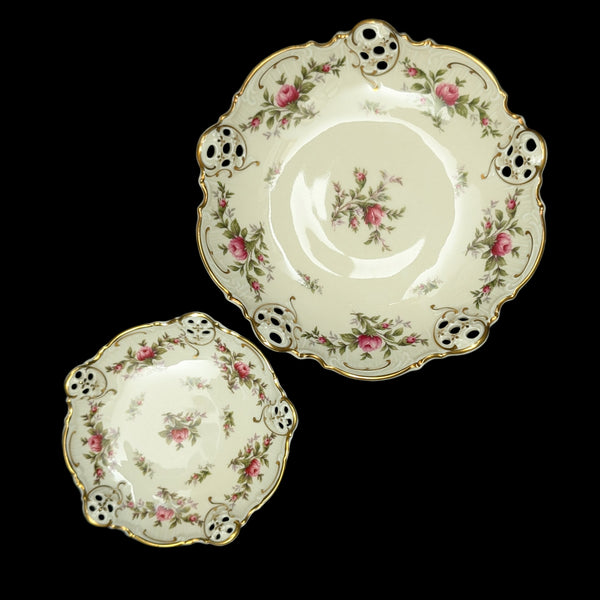
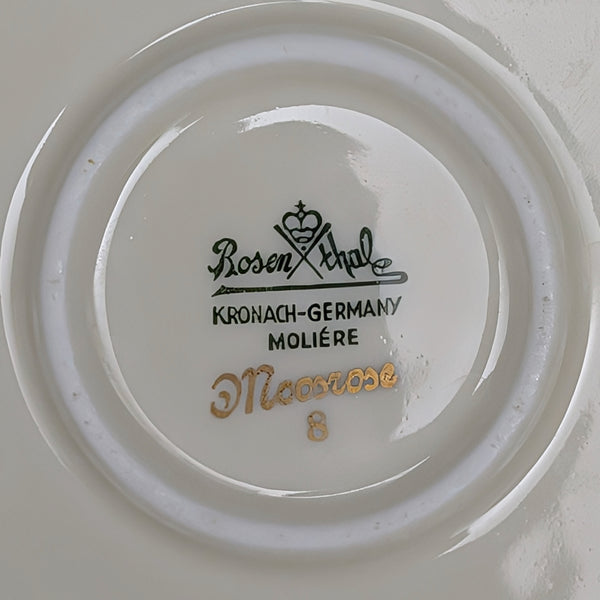
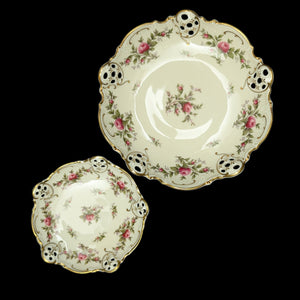
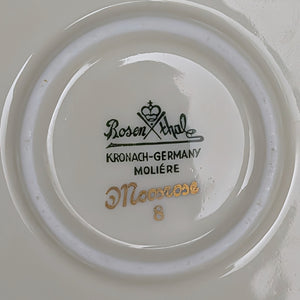
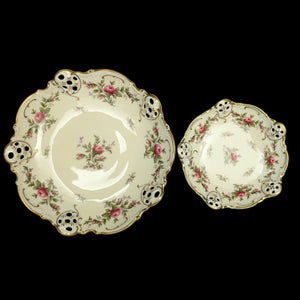
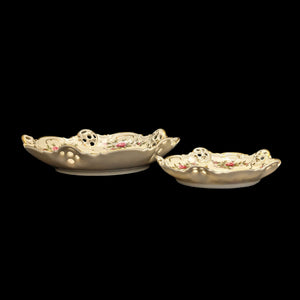
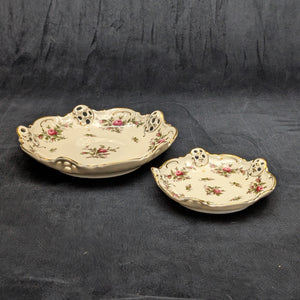
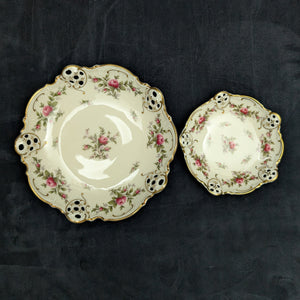
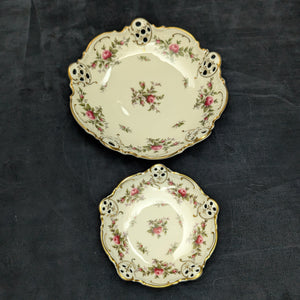
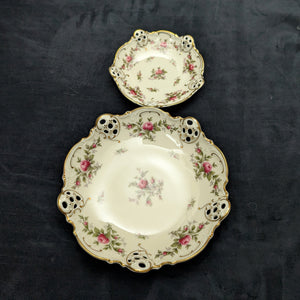
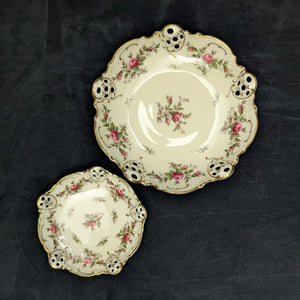
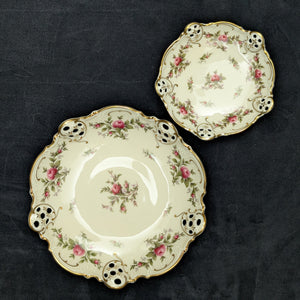
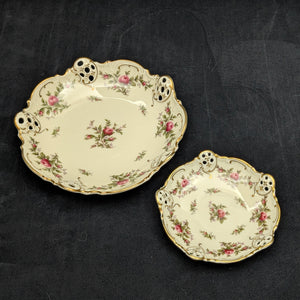
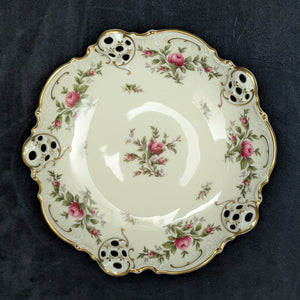
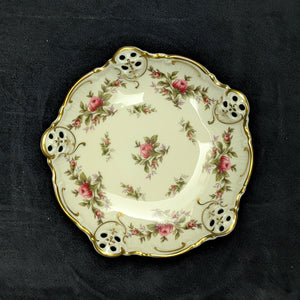
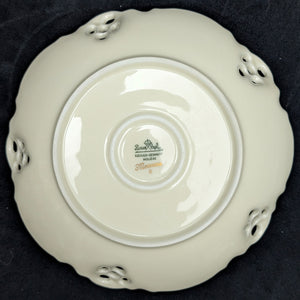
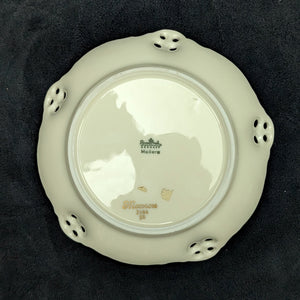
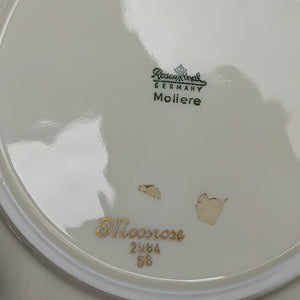
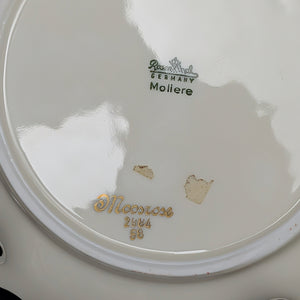
This is an exquisite antique porcelain set from the globally prestigious Rosenthal factory in Germany. The set includes two plates from the celebrated "Molière" form and "Moosrose" (Moss Rose) pattern.
These pieces are beautifully decorated with a classic hand-painted rose motif on a creamy body, framed by a heavily gilded, perforated rim. The clear mark on the base, including the "Molière" designation, confirms its quality and origin during the factory's golden era. This set is a strong acquisition for a collector of refined European tableware.
2. About the Porcelain Plates 📖✍️✨
This set comprises two serving pieces of distinct size, a larger plate (approx. 7 inches) and a smaller plate (approx. 5 inches). The form, known as "Molière," is characterized by its scalloped edge and the decorative reticulated (perforated) sections near the rim.
The central design features a realistic pink and red Moss Rose bouquet. This floral artistry is surrounded by intricate gold scrollwork and a distinctive border of openwork cutouts, which are fully gilded. The creamy, off-white body is often referred to as "Elfenbein" (Ivory) in Rosenthal catalogs. These dishes are ideal for serving small appetizers, confectionery, or as elegant cabinet plates.
3. About the Maker: The Rosenthal Group ✍️🏛️
The Rosenthal Group is a major German manufacturer, founded by Philipp Rosenthal in 1879, with a long history of artistic innovation and high-quality production. The mark visible on the base, "Rosenthal, Kronach-Germany, Molière," places this piece in the period when the company was producing its most celebrated classic forms.
The "Molière" form was one of the most successful and enduring shapes produced by the Kronach factory. Pieces from this series are known for their Rococo Revival style, showcasing the meticulous hand-finishing and gilding that established Rosenthal as a global leader in fine European porcelain.
4. Historical/Political Era Context 🌍🕰️📜
This set was produced during a period marked by the Art Deco and Post-World War I eras in Germany, likely between c. 1910 and 1935. The style, combining the ornate Rococo Revival Molière form with delicate floral motifs, reflects the enduring popularity of nostalgic, elegant tableware in Europe during periods of social and economic change.
The perforated (reticulated) rim is a detail that hearkens back to the 18th-century porcelain traditions of Dresden and Meissen, giving the piece a strong sense of historical depth. Rosenthal's production during this time was a symbol of sophisticated German craftsmanship, actively catering to an international market that valued this blend of traditional elegance and industrial quality.
5. The Ideal Collector 💡🧐🏛️
This RARE Rosenthal serving set will appeal to a sophisticated collector with a specific interest in fine European tableware. The ideal buyer is a Rosenthal Molière collector, an antique lover of highly ornate decorative plates, or a person curating a formal dining aesthetic.
The set's verifiable "Moosrose" pattern and reticulated, gilded rim ensure it is a desirable find. This piece is a strong asset for a collector who appreciates pieces with documented heritage and intricate, sculptural detailing.
6. Value & Rarity 💎✨🏛️
This set of Rosenthal plates is valuable for its verifiable maker's mark, popular pattern, and aesthetic complexity. It is genuinely antique, approximately 90 to 115 years old.
Its market value is sustained by its complete, two-plate composition and the meticulously preserved heavy gold gilding on the perforated rim. Pieces from the Rosenthal Molière form are generally highly sought after for their quality and beauty. The excellent condition ensures it retains its maximum collectible value.
7. Condition 🔎📚✨
This antique Rosenthal porcelain set is in excellent, well-preserved antique condition.
-
Structural Integrity: Both the large and small plates are free of chips, cracks, or repairs.
-
Artistry: The hand-painted rose motifs are vibrant and fully intact.
-
Gilding: The heavy gold trim and scrollwork on the scalloped and perforated rim are largely intact, showing minimal wear.
-
Marking: The Rosenthal Molière mark is clearly legible on the base.
8. Fun Facts & Unique Features 🤓📜🤩
-
Pattern Name: "Moosrose" translates to "Moss Rose", a specific type of garden rose, reflecting the popularity of naturalistic floral motifs in early 20th-century design.
-
The Reticulated Rim: The perforated (openwork) design on the rim is a labor-intensive technique in porcelain, requiring the removal of clay before firing, which adds a high degree of difficulty and artistry.
-
The Molière Form: The "Molière" shape, introduced by Rosenthal, is named after the great French playwright Jean-Baptiste Poquelin (Molière), linking the German porcelain to French high culture.
-
Factory Location: The "Kronach-Germany" mark indicates production at Rosenthal's factory in Kronach, which was established in 1901 and specialized in high-quality dinnerware and ornamental pieces.
9. Supporting Information 🏷️📦💰
-
Item Name: Moosrose Perforated Plates Set (Set of 2)
-
Maker/Factory: Rosenthal (Kronach Factory)
-
Form/Pattern: Molière Form / Moosrose Pattern
-
Period: Antique (c. 1910–1935)
-
Medium/Material: Hand-Painted Porcelain (Elfenbein/Ivory Body) with Gold Gilt
-
Decoration: Pink Rose Bouquets, Perforated/Reticulated Rim
-
Origin: Germany
-
Approximate Dimensions: Large Plate: 7.0 inches; Small Plate: 5.0 inches
-
Marking Transcription (Verbatim from Base): Rosenthal / KRONACH-GERMANY / Molière / Moosrose / 2984 / 58 (The numbers are likely decorator/form codes)

